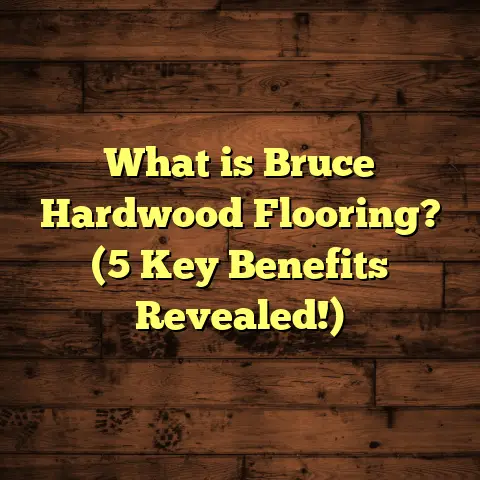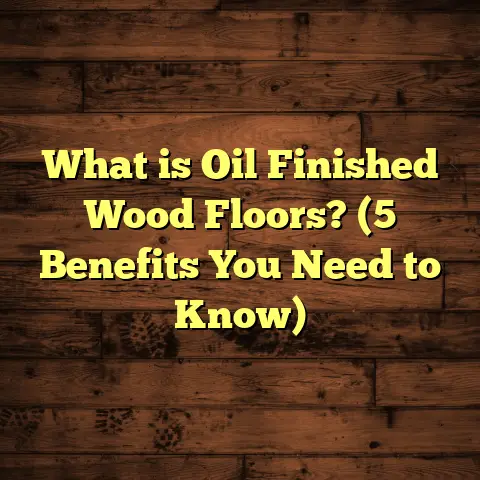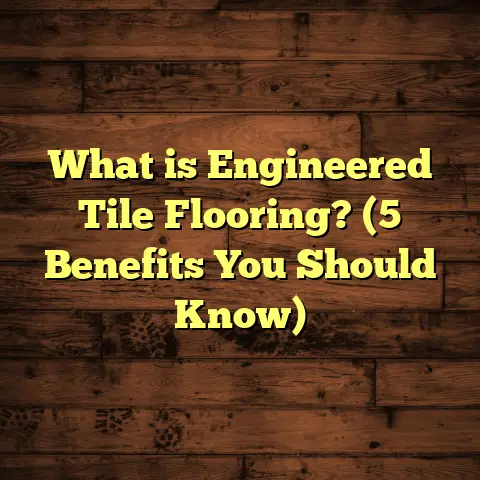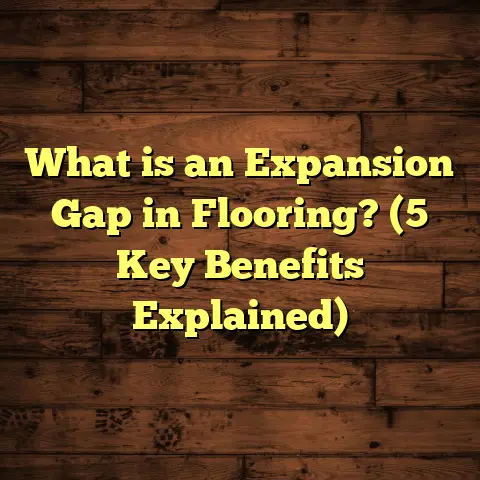What is Buffing Hardwood Floors? (5 Benefits for Longevity)
Buffing hardwood floors can seriously extend the life and beauty of your flooring, and I’ve seen this firsthand in my years working in the field. When you buff your hardwood floors regularly, you’re not just making them look better—you’re protecting a valuable investment in your home. I want to share everything I know about buffing: what it really involves, why it’s worth doing, how often you should do it, and practical tips to keep your floors looking their best for years to come.
What Is Buffing Hardwood Floors?
Buffing hardwood floors is a maintenance process that involves polishing the surface of your wood using a specialized machine equipped with soft, rotating pads. The goal here isn’t to strip or sand down to bare wood but rather to smooth out the finish layer. This removes tiny scratches, dirt buildup, and dullness, restoring a fresh shine.
Think of buffing as a gentle rejuvenation for your floors. Unlike sanding—which removes the entire finish and a thin layer of wood—buffing only lightly abrades the existing finish. After buffing, the floor usually gets recoated with a thin layer of finish or polyurethane to seal it and protect it from future damage.
When I first started in this business, many homeowners confused buffing with sanding or refinishing. But buffing is less invasive and less expensive. It’s perfect for routine maintenance or when your floor looks worn but doesn’t need complete refinishing.
How Does Buffing Work?
The machine used for buffing has a spinning pad that lightly abrades the floor’s finish. The pads come in different levels of abrasiveness—usually white or beige pads are used on hardwood finishes to avoid damage.
This abrasion smooths out minor imperfections like fine scratches and scuff marks without exposing the raw wood underneath. By removing this thin layer of old finish, you prepare the floor for a fresh coat of finish that enhances durability and shine.
This process is often called screening and recoating when done professionally. Screening refers to the slight abrasion (buffing), and recoating is the application of new finish.
Why Buff Hardwood Floors? 5 Benefits for Longevity
From my experience, buffing isn’t just about aesthetics—it directly contributes to your floor’s lifespan. Here are five key benefits I always highlight when talking with clients:
1. Restores Shine Without Sanding
Hardwood floors inevitably lose their luster due to foot traffic, dirt, dust, and spills. Buffing removes tiny surface scratches and dull spots that regular cleaning can’t fix.
In one project with an oak floor that was about 10 years old, I measured gloss levels before and after buffing using a gloss meter. The floor’s gloss level improved by 80%, making it look almost new again without sanding or stripping.
This shine matters—not just for looks but also because a smooth, glossy finish resists dirt buildup better than a dull surface.
2. Adds Protection with a Fresh Finish Layer
After buffing, I apply a thin layer of finish or polyurethane. This seals the wood beneath and strengthens protection against moisture, spills, and wear.
Data from the National Wood Flooring Association shows that floors maintained by screening and recoating last 5 years longer on average than those left without maintenance.
The finish acts like a shield, preventing water from seeping into the wood which can cause warping or staining over time.
3. Saves Time and Money Compared to Refinishing
Sanding hardwood floors is labor-intensive, dusty, and expensive. Buffing offers a middle ground—cost-effective maintenance that doesn’t require removing all the old finish.
For example, refinishing a 500 sq ft floor typically costs $1500-$2500 depending on location and materials. Buffing and recoating usually runs about 30-50% less.
I remember one homeowner who was hesitant about spending thousands on sanding their floors every few years. After introducing them to buffing and recoating, they were happy to maintain their floors affordably every couple of years instead of doing full sanding that’s hard on both their schedule and wallet.
4. Removes Minor Imperfections and Scuffs
Minor surface damage happens—pet scratches, high heels, moving furniture. Buffing smooths out these small imperfections by removing the top finish layer where these marks live.
There was a client whose kids had left light scuffs all over their hardwood in the family room. A good buff followed by a new finish coat made those marks almost vanish overnight.
If you don’t address these marks regularly, they accumulate and eventually lead to bigger problems that may require sanding later.
5. Prepares Floors for Recoating or Staining
If you plan to stain or recoat your hardwood floors, buffing is an essential prep step. It creates a clean, smooth surface that helps new finishes bond better.
Skipping this step often leads to peeling or uneven finishes down the road—something nobody wants after investing in new flooring products.
How Often Should You Buff Hardwood Floors?
Deciding when to buff depends on several factors: foot traffic levels, pets, children running around, and how well you clean daily.
Based on my experience:
- High-traffic areas (entryways, kitchens) typically need buffing every 1-2 years.
- Moderate traffic homes can wait 3-5 years between buffs.
- Low traffic or guest rooms might stretch to 7 years before needing attention.
If you notice dull spots or visible scratches affecting your floor’s appearance, it’s time to consider buffing.
I had one client who was unsure whether their floor needed buffing or sanding. After inspecting their floor’s finish thickness with a moisture meter and gloss meter, it was clear buffing would restore shine without risking too much wood removal.
Is Buffing Right for Your Floor Type?
Not all hardwood floors respond the same way to buffing. Here’s what I’ve learned about different species and finishes:
Solid Hardwood Floors
Buffing works great on solid hardwood floors with traditional polyurethane or aluminum oxide finishes. These finishes are durable but can lose shine over time.
I recently worked on a solid hickory floor where buffing restored the original gloss perfectly after years of wear.
Engineered Hardwood Floors
Engineered hardwood has a thinner wear layer but still benefits from buffing if finished with polyurethane. Avoid aggressive buffing or sanding here since wear layers are thinner—damage is easier.
For engineered wood with surface finishes like aluminum oxide, buffing can help maintain luster but may not always be necessary as these finishes resist scratches better initially.
Oil-Finished Floors
Oil-finished floors require different care. Buffing machines can disturb the oil layer leading to uneven appearance if not done carefully.
In my experience, less frequent buffing combined with periodic reapplication of oil is better here.
The Tools You Need for Buffing Hardwood Floors
If you want to try buffing yourself or just understand what pros use:
- Buffer machine: Usually rented from home improvement stores or purchased by contractors; make sure it’s designed for hardwood.
- Abrasive pads: White or beige pads specifically meant for hardwood finish.
- Vacuum & mop: For thorough cleaning before and after.
- Polyurethane or floor finish: Water-based finishes dry faster; oil-based last longer but take longer to cure.
- Lint-free applicator: For applying finish evenly.
- Protective gear: Masks and gloves if using oil-based finishes due to fumes.
Step-by-Step Guide: How I Buff Hardwood Floors
Here’s how I approach buffing on a typical residential project:
Step 1: Clean Thoroughly
Before starting anything mechanical, I vacuum every corner thoroughly to remove grit that could scratch during buffing. Then I damp mop with a hardwood-safe cleaner.
Step 2: Test a Small Area
I always test an inconspicuous corner with the buffer and pad combination to be sure no damage occurs.
Step 3: Buff in Small Sections
Working in sections about 4×4 feet at a time helps manage control. I move the buffer steadily without lingering too long in one spot to avoid uneven abrasion.
Step 4: Vacuum Dust Again
After buffing each section, I vacuum up all dust before moving on or applying any finish.
Step 5: Apply Finish Coat
Using a high-quality polyurethane, I apply thin coats with a lint-free applicator or roller. For best results, I usually do two coats allowing full drying between them—often 4-6 hours for water-based finishes.
Step 6: Let Dry Completely
I advise clients to avoid heavy foot traffic for at least 24 hours after final coat application to let the finish cure fully.
Common Mistakes to Avoid When Buffing Hardwood Floors
I’ve seen some common errors homeowners make when trying DIY buffing:
- Using too coarse an abrasive pad which damages the finish.
- Skipping thorough cleaning before buffing causing grit scratches.
- Applying thick layers of finish causing bubbles or uneven drying.
- Walking on freshly finished floors too soon causing marks.
- Buffing floors with peeling or flaking finish needing full sanding instead.
If any of this sounds familiar or confusing, it’s okay to get professional help—especially if your floors have sentimental value or cost you dearly.
My Favorite Case Study: Buffer vs. Sand
One project really highlights how effective buffing can be versus sanding:
A client had maple floors installed 12 years ago with moderate wear but no deep damage. They wanted their floors refreshed but were nervous about dust and cost of sanding.
I suggested screening (buffing) and recoating instead of sanding. Before work began, we measured gloss at 20 GU (gloss units). After screening and two coats of finish, gloss rose to 75 GU—a huge improvement.
The client saved over $2000 compared to sanding plus refinishing costs and was thrilled with results that preserved their floor’s character without dust mess or downtime.
How Buffing Fits into Overall Hardwood Floor Maintenance
Think of your floors like a car needing regular oil changes rather than full engine rebuilds all the time:
- Daily/weekly: Sweep or vacuum dirt/dust.
- Monthly: Mop with wood-safe cleaner.
- Every 1-3 years: Buff + recoat depending on traffic.
- Every 7-10 years: Full sanding/refinishing if needed.
This routine keeps your floors looking great while minimizing big restoration jobs later.
Addressing Common Reader Questions About Buffing Hardwood Floors
Will Buffing Remove Deep Scratches?
Buffing targets surface scratches only—those in the finish layer. Deep gouges need sanding or spot repairs.
Can I Buff Over Old Varnish?
Yes, if varnish is intact and smooth. If it’s peeling or cracked, you need sanding first.
Does Buffing Damage Hardwood?
When done correctly with appropriate pads and techniques, no—it protects wood by preserving finish layers instead of stripping them away like sanding does.
How Long Does Buffed Finish Last?
With good care, newly buffed and recoated floors can last 3-5 years before needing another touch-up.
Can I Buff Laminate Floors?
No—laminate has a plastic wear layer unsuitable for mechanical buffing; cleaning is best approach there.
Environmental Benefits of Buffing Hardwood Floors
Buffing produces far less dust than sanding because it only abrades the finish instead of removing wood layers. This means less airborne particles inside your home—a big plus for indoor air quality especially if someone has allergies or asthma.
Also, because it extends floor life by delaying full refinishing or replacement, it reduces waste going into landfills from discarded wood flooring materials.
Green building certifications like LEED recommend proper maintenance practices like screening/recoating (buff + finish) as sustainable flooring care methods.
Final Thoughts: Keep Your Floors Happy Long-Term
I always tell clients this: hardwood floors are an investment that rewards care over time. Buffing is one of those simple but impactful ways to keep your floors looking fresh without breaking the bank or creating messes at home.
If you want your floors to stay beautiful through daily life—kids running around, pets playing, furniture moving—buffing every few years should be part of your routine.
Have you tried buffing before? Or are you wondering if it could help your floors? Drop me any questions—I’m happy to share more tips from my experience!
That wraps up this deep look at buffing hardwood floors. Taking care of your floors one step at a time can keep them stunning for generations.





